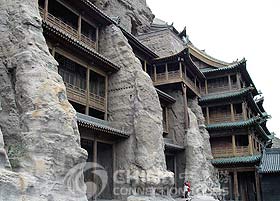Shanxi Province is situated in the middle of the Yellow River Valley. It's located west of the Taihang Mountains and its name, Shanxi, means west of the mountain. The provincial capital is Taiyuan and the province has a population of 32.97 million as of 2000, with the main ethnic groups being Han, Hui, Mongolian and Manchu.
Shanxi has a continental monsoonal climate with distinctive seasons. Spring is windy and the temperature varies greatly between day and night. Summer is hot and rainy. Autumn is short and mild. Winter is long, cold and dry. The annual average temperature is 12/20 degrees C, while the lowest temperature is -1/7 degrees C. Most of the province has an average rainfall of 400/500 millimeters, increasing gradually from northwest to southeast. The best season to visit is from April to October.
Shanxi is one of the places where Chinese civilization originated. Places in the province exhibit evidence of human settlement from over a million years ago. Huangdi (the Yellow Emperor), a famous legendary hero, is said to have traveled and lived in Shanxi, and the earliest rulers, Yao, Shun and Yu, all established their capitals there. Datong, known as Pingcheng in ancient times, was the capital of the Northern Wei Dynasty (386-534) and flourished throughout the Southern and Northern Dynasties (420-581). During the Sui (581-618) and Tang (618-907) Dynasties, Shanxi became very prosperous.
Shanxi people were once called Chinese Jews, indicating that they were people of wisdom and good at business.
 Shanxi abounds in tourism resources. Famous spots include the Yungang Grottos at Datong City in the north, Wutai Mountain, a sacred place of Buddhism in the center, and the falls at Hukou Waterfall in the south, the only waterfall on the Yellow River.
Shanxi abounds in tourism resources. Famous spots include the Yungang Grottos at Datong City in the north, Wutai Mountain, a sacred place of Buddhism in the center, and the falls at Hukou Waterfall in the south, the only waterfall on the Yellow River.
The province is home to the country's largest temple of martial valor, the Guan Yu Shrine at Xiezhou, and one of the four large whispering buildings in China, the Yingying Pagoda of Pujiu Temple in Yongji County.
Statistics show that Shanxi now has a total of 31,401 unmovable cultural relics. They consist of 2,639 ruins of ancient monuments, 1,666 ancient graves, 18,118 old buildings and memorial structures of historic interest, 300 grottoes and temples, 360 sites bearing ancient vertebrate fossils, 6,852 sites with stone inscriptions and 1,466 old revolutionary sites and memorial buildings.
There are 12,345 painted sculptures in these old buildings and memorial structures of historic interest and 26,751 square meters of murals in old temples.
In Shanxi, the most famous food is Daoxiao Mian (Knife-Pared Noodles), Shaomai (steamed dumplings with the dough gathered at the top), and Youmian (Naked Oats Noodles). Traditional specialties such as Fen wine, Zhuyeqing wine, Qingxu vinegar and Changzhi ginseng are some sought after products. Local folks arts that will interest tourists include Shanxi Bangzi (Shanxi Opera), Huagu (Flower Drum), and Yangge, a popular rural folk dance.

